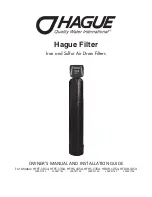
4
Hague Filter Owner's Manual
NORMAL
OPERATION
POSITION
BYPASS POSITION
DIAGNOSTIC
POSITION
SHUT OFF
POSITION
FIGURE 1
FIGURE 3
FIGURE 2
FIGURE 4
The bypass valve is typically used to isolate the control valve from the plumbing system’s water pressure in order to perform control
valve repairs or maintenance . The 1” full flow bypass valve incorporates four positions, including a diagnostic position that allows a
service technician to have pressure to test a system while providing untreated bypass water to the building . Be sure to install bypass
valve onto main control valve, before beginning plumbing . Or, make provisions in the plumbing system for a bypass . The bypass body
and rotors are glass-filled Noryl® and the nuts and caps are glass-filled polypropylene . All seals are self-lubricating EPDM to help prevent
valve seizing after long periods of non-use . Internal O-Rings can easily be replaced if service is required .
The bypass consists of two interchangeable plug valves that are operated independently by red arrow shaped handles . The handles
identify the direction of flow . The plug valves enable the bypass valve to operate in four positions .
1.
NORMAL OPERATION POSITION:
The inlet and outlet handles point in the direction of flow indicated by the engraved
arrows on the control valve . Water flows through the control valve for normal operation of a water softener or filter . During the
regeneration cycle this position provides regeneration water to the unit, while also providing untreated water to the distribution
system
(Fig. 1)
.
2.
BYPASS POSITION:
The inlet and outlet handles point to the center of the bypass . The system is isolated from the water
pressure in the plumbing system . Untreated water is supplied to the building
(Fig. 2)
.
3.
DIAGNOSTIC POSITION:
The inlet handle points toward the control valve and the outlet handle points to the center of bypass
valve . Untreated supply water is allowed to flow to the system and to the building, while not allowing water to exit from the system
to the building
(Fig. 3)
. This allows the service technician to test the unit and perform other functions without disrupting the water
going to the building .
NOTE
:
The system must be rinsed before returning the bypass valve to the normal position.
4.
SHUT OFF POSITION:
The inlet handle points to the center of the bypass valve and the outlet handle points away from the
control valve . The water is shut off to the building . The water treatment system will depressurize upon opening a tap in the building .
A negative pressure in the building combined with the unit being in regeneration could cause a siphoning to the building . If water
is available on the outlet side of the unit, it is an indication of water bypassing the system
(Fig. 4)
(i .e . a plumbing cross-connection
somewhere in the building) .
Bypass Valve





































